| Part 6 Fez |
|
|
I happened to watch NHK-BS3 featuring "Fez" two weeks before
the trip. It was probably a part of the introduction series of Morocco.
Most of the contents were Medina, the old town of Fez, and especially Fes
el Bali, so-called the greatest maze in the world, was the highlight.
I enjoyed the program of 45 minutes.
|
|
|
This maze is one of the main attractions of any tours around Morocco.
The tourist magazine "How to walk on the Earth" published by
Diamond Co. describes as follows.
Fes el Bali, the town of the most complicated mazes in the world. The roads
are narrow, full of ups and downs, bending back and forth, ... Due to many
slopes, the means of transportation are donkeys and horses through the
narrow mazes, where people barely pass each other.
People get under the illusion that they are walking the same road to and fro. Moreover, the narrow roads are between high buildings and have tunnels which make the sun direction unclear. ...
|
|
|
Though it was a rare matter, we found a briefing session on the Morocco
trip would be held, and went to the hall at Shimbashi thinking Morocco
is different from our usual traveling places.
The DVD handed out there advertised "The Maze in Fez" a lot.
- - - - -
|
|
 |
| Fez from the viewpoint of a hill |
|
In the bus on the way from Marrakech to Ait Benhaddou, Ms. Karimai, an
attendant, said.
"We are going to see the sight of Fez on the 7th day. I suppose most
of you are expecting the greatest maze in the world there. To my regret,
it is just the Sacrifice Festival Day of Islam."
She talked, lowering her tone of voice.
"We will walk along the maze as expected, but I am afraid it will
not be as usual. While you will experience a rare atmosphere of the Sacrifice
Festival, the maze itself may be considerably quiet and different from
the guidebook introduction."
- - - - -
We actually walked enough along the greatest maze in the world all right, but could not come in contact with such a peculiar atmosphere of a super low city like the narrow maze with jam-packed people, with small stores on both sides and with donkeys walking among the packed people.
There could surely be no chance of a tragedy to be lost through the bustle
of the maze.
Instead, we were able to experience the Sacrifice Festival along the maze
in Fez never seen other than in Islamic countries.
Now I am going to write about the day in sequence.
|
|
|
Morocco ia among the Islamic countries with 1.2 billion people, 20 % of
the whole world. On the special day of Sacrifice Festival, it is sunny
and refreshing in Fez, the oldest town in Morocco.
We left the hotel at 9:00 and headed for Palais Royal (Royal Palace).
Royal Palace is said to possess the extensive land of Fes el Jedid, an
old town created in the 13th century. Though we were not able to enter
it, it was easy to see the reason why in the old days just by looking at
the gorgeous main gate.
Many National flags are fluttering here all over the country. Such natural views make us in a happy mood.
|
|
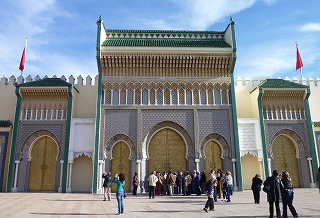 |
|
|
Our bus left the town for a while and went up a view point on the hill,
where we could see the whole town.
The two so-called Medinas, Fes el Bali, an old town in the 9th century,
and Fes el Jedid, are mixed from the both sides. Facing them the new town
seems to be widened.
|
|
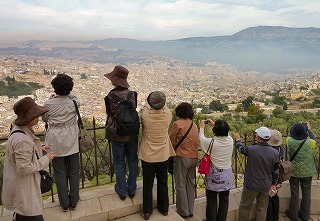 |
|
| We go through Bab Bou Jeloud, Jeloud Gate, the entrance to Medina. |
|
 |
|

It is said to be the largest gate in Fez built in 1913, with blue and green
tile in a geometric pattern sculpture. |
|
|
We visited a Berber family.
The house is comfortable with a patio not matched to the exterior appearance
seen from a path.
After our quick look around the house inside, the house lady showed us how to make mint tea carefully, and we basked in a friendly atmosphere hearing the drum play of the host.
Then, walking along a narrow road, we visited works of pottery and chasing.
At the small block of dyeing and weaving craft-people, we entered a 4-story
store and spent time for shopping, looking down over a workshop along the
river.
If not during the Sacrifice Festival, Medina would have been so crowded
that we would not have this kind of leasure, not mentioning the maze.
|
|
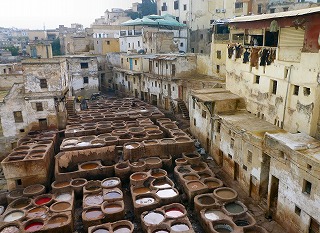 |
|
|
Slow lunch at a residential restaurant.
Well, we are now really experiencing National Holiday of Sacrifice Festival.
Every street is desolate, every store is closed in a souq (market) and
every viewpoint on the way is also closed. We have too much time to kill.
Are other Islamic places or countries in the similar circumstances?
Really quiet. How different is this quietness from that of the new year's
days in some country? One big difference is a sheep.
After entering Jeloud Gate, whether we liked it or not, we had to see sheep
for the sacrifice offering taken to the place of fate here and there.
As mentioned before, we walked along the complicated maze, which was desolate
everywhere contrary to the expectation.
|
|
 |
|
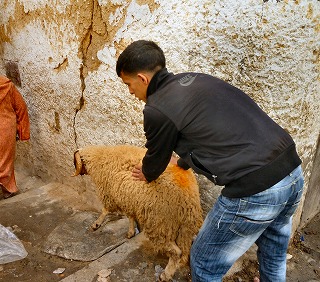 |
|
|
What are up on the open-air fire? They must be the heads of sheep after
sacrificed. Furs skinned, collected blood on the ground, ..., no more allowed
to say.
|
|
 |
|
|
And now the real tour along the maze.
Along both the narrow alleys and tunnels, too, vivid furs are piled up
at the corner and offerings are carried on a back of a horse or a donkey.
|
|
 |
|
|
The head is burned and divided by a saw. Sheep casings are hanging down
from a rod, ...
I gave up taking pictures, and remembered the famous Japanese song "Hakone
Hachiri" (The 36-km slope on Mt. Hakone), which says "The path
of sheep casing is smooth by a moss." The maze is so narrow and so
long like sheep casing.
|
|
|
Taiji Town in my home country Nanki-Kumano gained notoriety by the documentary
movie "The Cove" last year in 2009.
I don't know how to vent my pent-up indignation as one of the common local people who ate dolphin and whale meat with no resistance or discomfort during young days, but cannot help feeling the difference of culture.
Back to the story, how do people in a country other than Islam feel seeing
this scene? One million sheep are said to be killed for this day only in
Morocco. How many in the world? Goats or cows in some countries.
This is one culture stemmed from their life and history, so I believe nobody
has any intention of slaughter. Really sorry for sheep, but it is one human
way of how to worship God. Thinking this way, I passed by.
A lot of turkeys are to be offerings on Christmas day in Christian countries,
and Japan has followed it recently.
11 years ago in 1999, I climbed Mt. Myojin-gatake in Hakone area with mountain-walking
friends. Now I remember the passage of the travelogue at that time.
"I relaxed on the Cristmas Eve for the mountain-walking next day.
Our couple ate chicken dark meat with a little of wine, recalling the former
Prime Minister Miyazawa's following talk. 'There is no turkey eagerly waiting
for Christmas, is there?'."
- - - - -
Not only this day, why was it we did not see any mutton or lamb at any
meal through the travel? I tilted my head eating other meat in a tajine. |
|
| The maze tour was disappointing even if we had already known it. |
|
 |
|
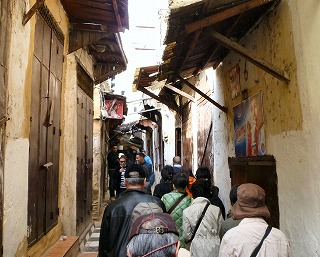 |
|
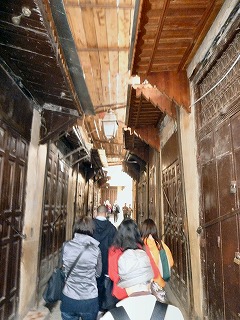 |
|
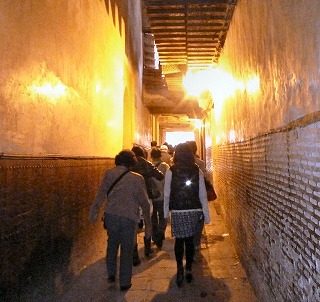 |
|
|
As you notice, we walked along the narrow maze shown on TV and DVD, but
it was quiet everywhere.
No shops in a market called "souq" are open. Only a few horses
and donkeys with offerings on the back are sometimes coming and going along
the maze. What are the residents here doing now? Are they enjoying some
quality time with their families? Or are they praying in a mosque? They
must be enjoying a pious and peaceful day eating the offering feast.
So, we tourists have no worry to be lost along any mazes. We really walked
as we liked and felt lonely.
Concerning the Sacrifice Festival, I mention it in the last chapter.
|
|
| Fez, Other Pictures |
|
| Reading: 14:32 |
|

